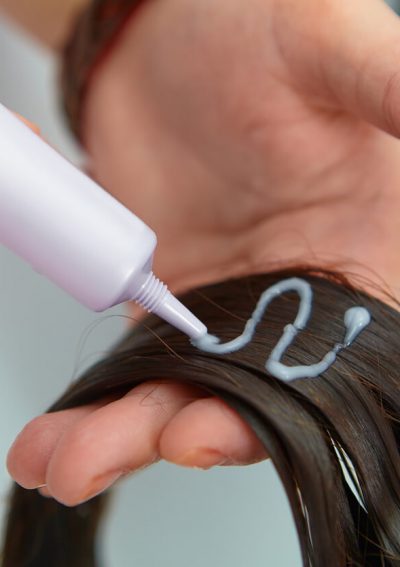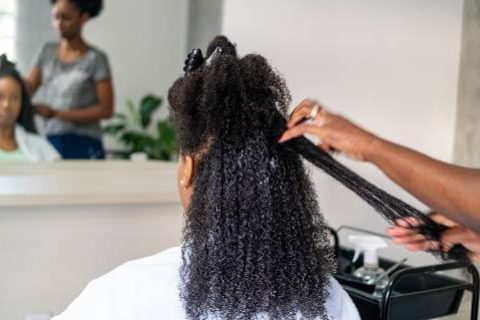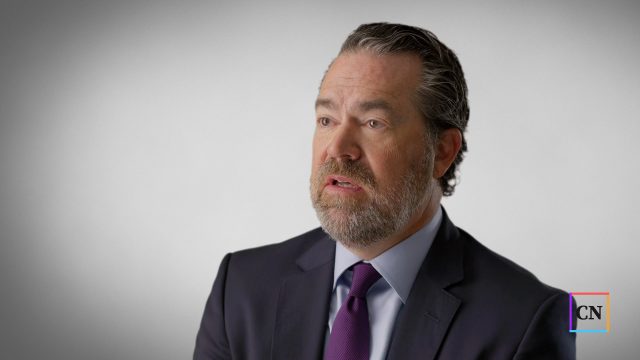Are Chemical Hair Straighteners Safe?
Using chemical hair straighteners may increase the risk of uterine cancer, fibroids, breast cancer and endometriosis, according to studies. Side effects of frequent chemical hair straightener use include weakening of hair, increased frizz, hair discoloration and scalp inflammation.

What Are Chemical Hair Straighteners?
Chemical hair straighteners are lotions or creams that break down the protein structure of curly hair to permanently straighten it. Unlike heat straightening or serum straightening, chemically straightened hair stays straight until the hair grows out.
Professional stylists administer most chemical hair straighteners at a salon because of the potentially harmful chemicals involved. There are a few kits that allow people to chemically straighten their hair at home, but they are typically weaker formulas that might be less effective. Chemical hair straighteners contain harsh chemicals that can damage hair over time and irritate the scalp.
Chemicals in hair straighteners include cyclosiloxanes, formaldehyde, parabens, diethanolamine, sodium hydroxide, phthalates, triclosan and benzophenone-3, according to California’s Department of Toxic Substances Control. Studies have linked these chemicals to a higher risk of health problems such as cancer, fibroids and endometriosis.
Types of Chemical Hair Straighteners
Types of chemical hair straighteners, sometimes called relaxers, include traditional chemical straightening, Japanese straightening and Brazilian Keratin treatments.
Each type of straightening works for different levels of curly hair from very curly to slightly wavy or frizzy hair. Stronger chemical treatments work for very curly hair and last longer but are more damaging to the hair and scalp.
- Traditional Chemical Straighteners: Typically made with sodium hydroxide to permanently straighten hair, these hair relaxers cause the most irritation to the scalp and damage to hair.
- Japanese Heat Straighteners: Also known as thermal reconditioning, it uses ammonium thioglycolate, lasts four to six months and is slightly less damaging to hair.
- Brazilian Straighteners: Keratin treatments are not for very curly hair and last about three months. They smooth hair without breaking protein bonds and some contain formaldehyde.
Chemical hair straighteners are further classified as lye-relaxers, no-lye relaxers and thio relaxers depending on the product’s ingredients. Permanent lye-relaxers have the harshest chemicals and potentially do the most long-term damage to hair.
How Do Chemical Hair Straighteners Work?
Chemical hair straighteners use a chemical cream to break protein bonds in the hair called disulfides. Hair that is curlier has more disulfide bonds. Stronger chemicals are needed to break these bonds in curlier hair.
After the bonds are broken, the stylist will apply a neutralizer to reform the disulfide bonds. While reforming the bonds, the stylist will configure the hair into its new shape to straighten it.
Gentler chemical hair straighteners use weaker chemicals to straighten hair, but they don’t last as long and won’t work on very curly hair. Some types of straighteners, such as Japanese straightening or Keratin straightening, don’t allow you to wet your hair or wash it for a few days after.
Using Chemical Hair Straighteners Safely
The safest way to use chemical straighteners is to have a professional stylist apply the chemicals for you. Stylists are trained to properly apply chemicals that can cause damage to your scalp and skin.
If you are using a home kit to straighten your hair, make sure to follow all instructions and precautions. Set timers to avoid over-processing your hair. To prevent skin irritation, you can use petroleum jelly or base oils on your scalp and hair line.
Chemically straightening your hair can cause long-term hair damage and scalp irritation. Over time, reapplying chemicals over previously straightened hair causes it to get weaker and break.
Side Effects of Chemical Hair Straighteners
Chemical hair straightener side effects include short-term problems including scalp irritation and hair damage as well as long-term side effects such as an increased risk of endometriosis. Studies have also linked hair straightening products and cancer.
A recent 2022 National Institute of Health study found women who used chemical hair straighteners had more than double the risk of uterine cancer compared to women who didn’t use them. Another NIH study In 2019 found women who used chemical hair straighteners had a 30% increase in incidence of breast cancer. Black women are particularly at risk because they use hair straighteners at higher rates than other consumers.
- Allergic reactions
- Burns
- Damage to the hair shaft
- Eczema
- Frizzy hair
- Hair discoloration
- Hair loss and/or alopecia
- Scalp inflammation
- Scalp irritation and pain
- Skin atrophy
Women who used straighteners and later developed uterine, endometrial and ovarian cancer filed chemical hair straightener lawsuits naming manufacturers including L’Oreal, Dark & Lovely and Namaste as defendants. Plaintiffs said defendants sold these harmful products even if they knew they could cause cancer and failed to warn the public.
Alternatives to Chemical Hair Straighteners
The most reliable alternatives to chemical hair straightening is heat styling with hair serums made without harsh chemicals. These methods will only last a day or two, but they are safer than chemical straightening.
Heat styling can also damage hair but doesn’t carry a risk of cancer or other reproductive system issues. To reduce damage from heat styling, use a heat protectant on your hair, use the right temperature for your hair type and make sure the hair is properly conditioned after.
Several online recipes for natural hair straighteners made with coconut milk, fruits or oil promise effective straightening. But these methods might not be reliable.
12 Cited Research Articles
Consumernotice.org adheres to the highest ethical standards for content production and references only credible sources of information, including government reports, interviews with experts, highly regarded nonprofit organizations, peer-reviewed journals, court records and academic organizations. You can learn more about our dedication to relevance, accuracy and transparency by reading our editorial policy.
- In Re: Hair Relaxer Products Liability Litigation. (2022, November 15). Memorandum In Support Of Plaintiffs’ Motion For Transfer Of Actions Pursuant To 28 U.S.C. § 1407 For Coordinated Or Consolidated Pretrial Proceedings. Retrieved from https://www.aboutlawsuits.com/wp-content/uploads/2022-11-15-MDL-Motion.pdf
- Samuelson, K. (2022, November 14). Uterine fibroid growth activated by chemicals found in everyday products. Retrieved from https://news.northwestern.edu/stories/2022/11/uterine-fibroid-growth-activated-by-chemicals-found-in-everyday-products/
- Howard, J. (2022, October 24). US woman files lawsuit against L’Oréal, claiming chemical hair straightening products are linked to her cancer. Retrieved from https://www.cnn.com/2022/10/24/health/hair-straightening-products-lawsuit
- Chang, C-J et al. (2022, October 17). Use of Straighteners and Other Hair Products and Incident Uterine Cancer. Retrieved from https://pubmed.ncbi.nlm.nih.gov/36245087/
- Adams, C. (2022, October 17). Chemical hair straighteners linked to higher risk of uterine cancer for Black women, study shows. Retrieved from https://www.yahoo.com/video/chemical-hair-straighteners-linked-higher-234101030.html
- L’Oreal. (2022, July 27). Everything You Should Know Before Getting a Hair Relaxer. Retrieved from https://www.lorealparisusa.com/beauty-magazine/hair-care/all-hair-types/relaxed-hair
- Nathache, J. et al. (2022, March 11). Effects of chemical straighteners on the hair shaft and scalp. Retrieved from https://www.sciencedirect.com/science/article/pii/S0365059621003147
- California Department of Toxic Substances Control. (2022). Chemicals in Hair Straightening Products. Retrieved from https://dtsc.ca.gov/scp/chemicals-in-hair-straightening-products/
- National Institute of Environmental Health Studies. (2019, December 4). Permanent Hair Dye and Straighteners May Increase Breast Cancer Risk. Retrieved from https://www.niehs.nih.gov/news/newsroom/releases/2019/december4/index.cfm
- Nazir, S. et al. (2018). Women Diagnosed with Endometriosis Show High Serum Levels of Diethyl Hexyl Phthalate. Retrieved from https://www.ncbi.nlm.nih.gov/pmc/articles/PMC6094529/
- University of Melbourne. (2017, October 22). How does hair straightening actually work? Retrieved from https://blogs.unimelb.edu.au/sciencecommunication/2017/10/22/how-does-hair-straightening-actually-work/
- Pantene. (n.d.). Straight Talk. Retrieved from https://www.pantene.com.au/en-au/brandexperience/straight-talk
Calling this number connects you with a Consumer Notice, LLC representative. We will direct you to one of our trusted legal partners for a free case review.
Consumer Notice, LLC's trusted legal partners support the organization's mission to keep people safe from dangerous drugs and medical devices. For more information, visit our partners page.
866-461-6220


